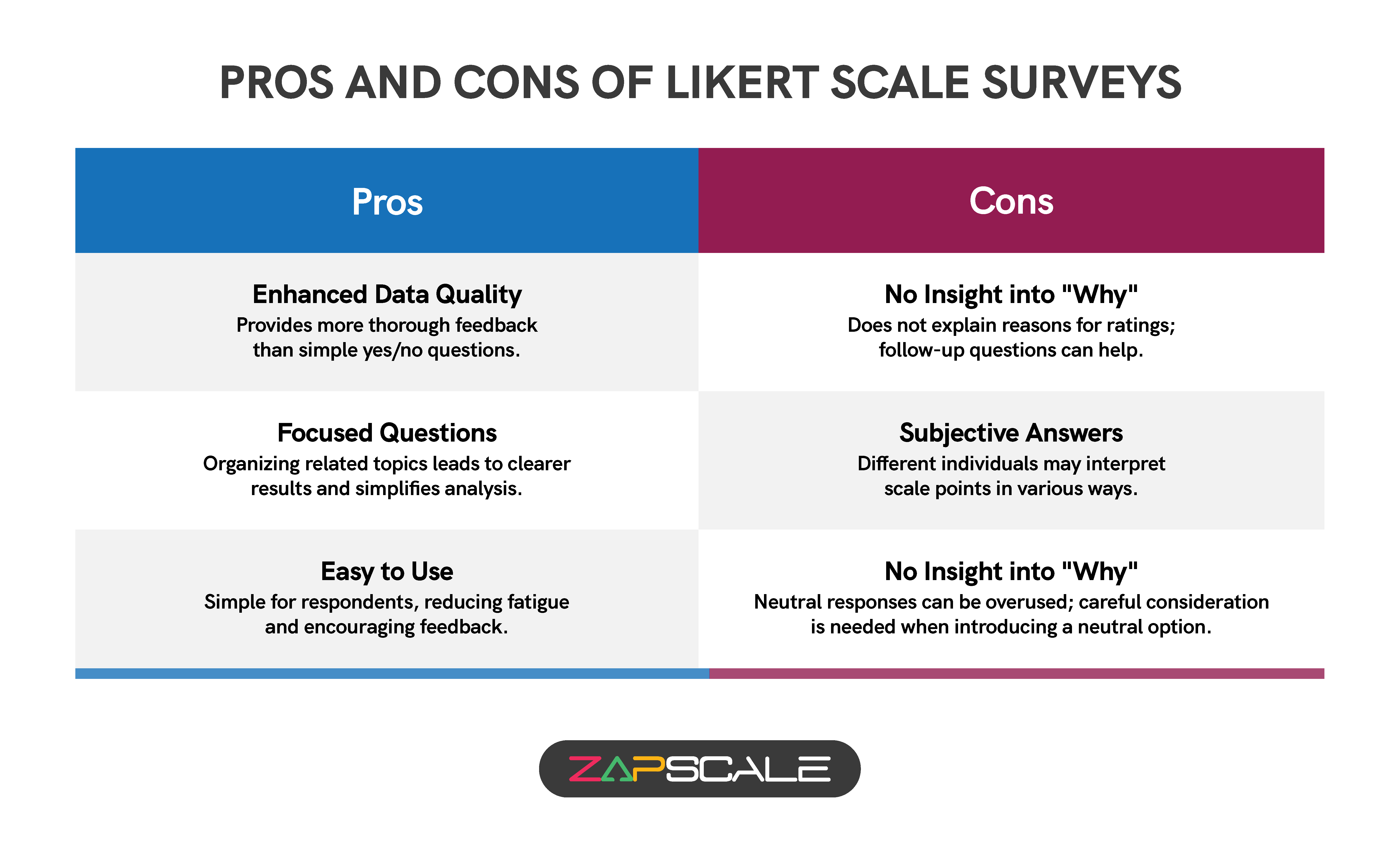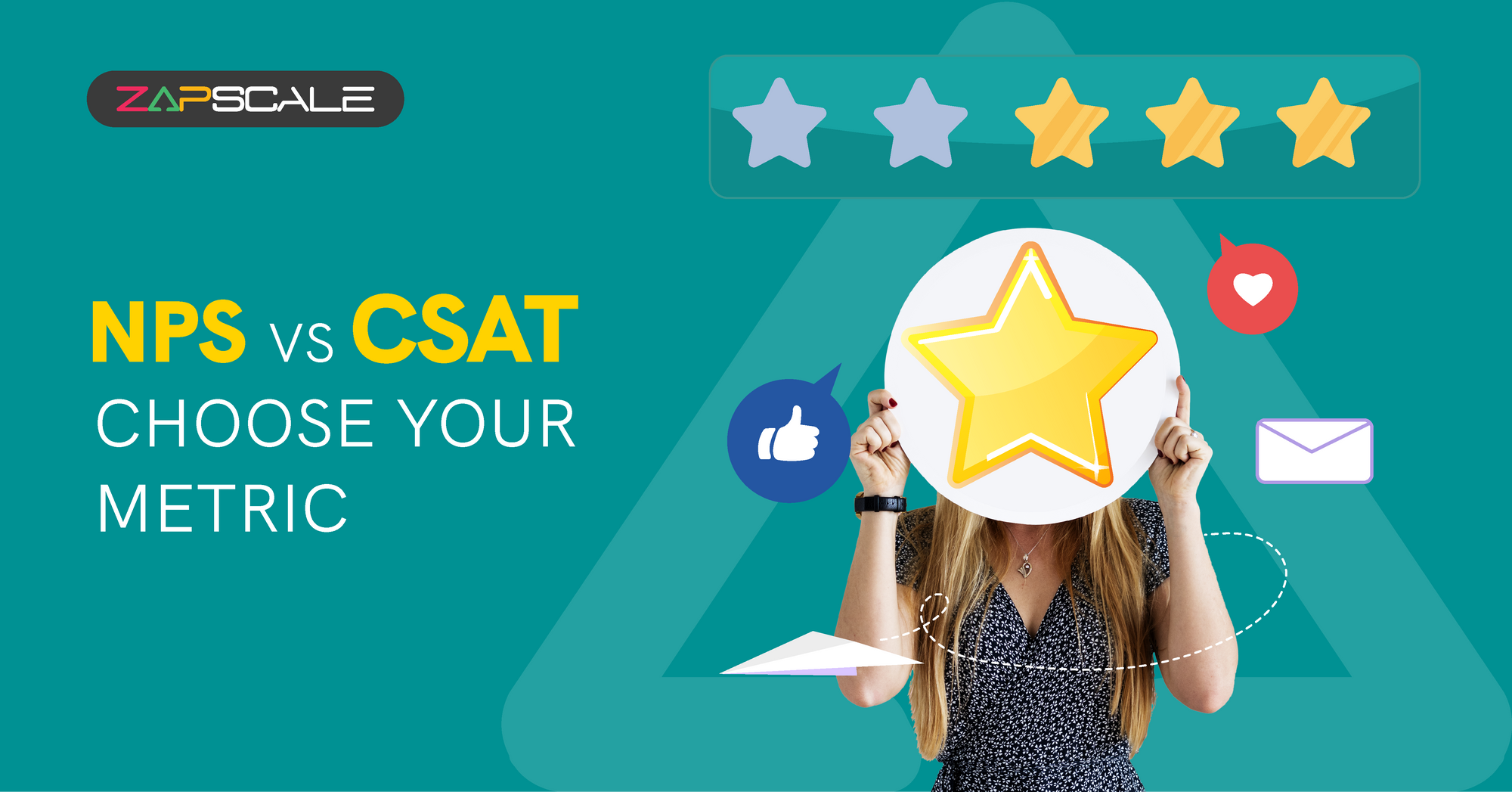CATEGORY > Customer Satisfaction
Likert Scales 101: The Ultimate Guide to Effective Data Analysis for Surveys

Introduction
Introduced by Rensis Likert in 1932, Likert scales are versatile tools for evaluating opinions and attitudes, offering structured insights for businesses.
Let’s dive deeper into understanding likert scales, focusing on how to use likert scales effectively and interpret likert scale results like a pro.
An Overview Of Likert Scales
A likert scale is a survey technique that uses a variety of responses to assess opinions and attitudes. Instead of answering simple yes/no questions, participants score their feelings, such as "somewhat like it."
This strategy is popular in psychology and market research because it effectively captures nuanced opinions. Typical response options range from "strongly agree" to "strongly disagree," allowing researchers to gather precise information regarding customer happiness and product features.
How Valuable Are Likert Scales?
Likert scales are basic and straightforward allowing responders to select options easily. They focus on certain emotions, minimize the inconvenience by providing more options, and effectively capture the sentiment. This enables firms to analyze customer satisfaction and direct follow-up research to improve solutions.
Types Of Likert Scale Questions
A likert scale is a popular tool for gathering quantitative data on thoughts, opinions, and behaviors. They provide more complex feedback than simple binary questions, helping you determine if a product is "good enough" or "excellent."
There are several types of likert scale questions as listed below:
- Likelihood: Measures someone's likelihood of taking an action, such as shopping.
- Satisfaction: Evaluate customer satisfaction with your products.
- Importance: Determines how passionately people feel about a product or service.
Likert scales can have different points, like 4, 5, 7, or 10, to provide varying levels of depth.
The 11-point net promoter score assesses customer loyalty, whereas frequency scales determine how frequently something occurs. Use a 7 or 10-point scale for detailed feedback, and a 4 or 5-point scale for basic questions.
1. The 4-Point Likert Scale: A Tool For Continuous Improvement
The 4-point likert scale assesses opinions with no middle ground, forcing respondents to pick between positive and negative possibilities.
For instance, a question could be, "How easy was it to navigate our website?" This scale is clear and straightforward, providing significant insights for organizations looking to improve their products.
2. Using The 5-Point Likert Scale To Measure Engagement
The 5-point Likert scale measures engagement with responses from "very difficult" to "very easy," including a neutral option. It captures nuanced opinions effectively. To leverage a 5-point likert scale, you must use precise language and balance positive and negative statements. Utilize charts to visualize the data for understanding likert scales.
3. Creating Impactful Surveys With The 6-Point Likert Scale
A 6-point Likert scale provides more options than a 4-point scale, facilitating extensive feedback collection.
For example, responses on app usage can range from "never" to "very often." Visualizing findings offers important insights while comprehending neutral reactions can show areas for development and increase overall satisfaction.
4. Using The 7-Point Likert Scale To Measure Brand Loyalty
The 7-point likert scale has seven response alternatives, which allows for more specific thoughts than the 5-point scale. It's great for surveys, delivering extensive data.
For example, inquiring about the possibility of repurchasing a product might help you better understand customer preferences and target market insights.
5. The 10-Point Likert Scale
10-point Likert scales provide ten response alternatives for comprehensive feedback, such as "1" (very dissatisfied) to "10" (very satisfied). It collects nuanced sentiments, which are frequently used to measure customer satisfaction and brand loyalty, integrating detail with simplicity in survey responses.
6. The Frequency Likert Scale: A Breakthrough For Research Enthusiasts
The frequency likert scale indicates how frequently respondents engage in various habits, such as shopping. For example, a survey might ask, "How often do you exercise each week?" with responses like "always" to "never." This simple approach collects useful information about product consumption and customer patterns, making it accessible and beneficial for researchers and businesses.
Is Your Data Ordinal? The Truth About The Likert Scale
The likert scale is a sort of data with a distinct order, but the intervals between values are not equal. When numerous likert scale questions are combined into a single score, it might be viewed as a new form of data.
Overall likert scale scores, on the other hand, are sometimes analyzed as interval data because they imply directionality and can be considered to have equal spacing. It is critical to grasp this distinction when evaluating Likert scale findings in surveys and research to secure correct conclusions.
The Bright Side And Pitfalls Of Likert Scale Surveys

1. Pros
a. Enhanced Data Quality
Gather more thorough feedback than simple yes/no questions.
b. Focused Questions
Organizing related topics produces clearer results and simplifies analysis.
c. Easy To Use
Effortless for respondents, eliminating fatigue and promoting feedback.
2. Cons
a. No Insights Into "Why"
Doesn’t explain reasons for ratings; follow-up questions can assist.
b. Subjective Answers
Several individuals may perceive scale points differently.
c. Risk Of Inaccurate Data
Neutral responses can be overused so maintain anonymity and think hard about introducing a neutral option.
Real-World Applications Of Likert Scale
Likert scale surveys are versatile tools used across different sectors. Here are some common likert scale examples and applications you must uncover:
1. Net promoter Score (NPS)
- Gauges customer loyalty.
- Asks, “How likely are you to recommend this company?” on a 0 to 10 scale.
- Classifies reactions into detractors, passives, and promoters.
2. Customer Satisfaction Score (CSAT)
- Assesses satisfaction with certain areas, such as check-out speed.
- Responses are measured on a likert scale - very satisfied to very dissatisfied.
3. Customer Insights
- Collects feedback on preferences, such as the significance of appealing packaging.
- Helps marketing and product teams personalize offerings.
4. Website Feedback
- Considers UX and simplicity of usage.
- Asks how likely visitors are to return for further information, ensuring a strong brand image.
Understanding CSAT: Turning Data Into Actionable Insights
After designing your likert scale survey, the following step is to examine the results. As likert scales are ordinal, use the median or mode rather than averages. Examine how responses are distributed and compute percentages for each category, using bar graphs to show the results.
Understand that social desirability bias might influence answers, causing people to select socially acceptable responses over their real feelings.
eNPS Explained: Your Go-To Metric For Employee Sentiment
eNPS, or employee net promoter score, is an effective measure for determining how employees feel about their workplace. It entails asking them a single question: "On a scale of 0 to 10, how likely are you to recommend working here to a friend or colleague?"
The responses are divided into three categories as follows:
1. Detractors (0-6)
- Unhappy employees.
- Unlikely to recommend the company.
- This can lead to attrition and negative word-of-mouth.
2. Passives (7-8)
- Satisfied but indifferent.
- Not actively engaged with the company.
3. Promoters (9-10)
- Loyal employees.
- Best company advocates.
Analyzing eNPS can help businesses enhance employee satisfaction and retention, resulting in a more favorable workplace environment.
The Essentials Of Conducting Effective Employee Engagement Surveys
Employee engagement surveys assess employees' dedication to your company's vision and objectives. These surveys, which use technologies such as likert scale questions, provide information about training, career development, and policies. To create an effective survey, clearly outline your objectives and select relevant questions.
Ensure anonymity to encourage honest input, and distribute the survey via easily accessible venues. After gathering responses, examine the data to find trends and areas for improvement.
While positive individuals may appear involved, genuine engagement demonstrates an emotional commitment to their work. By routinely measuring and enhancing key engagement elements, you can develop a more productive workforce and foster a healthier organization.
How Likert Scales Are Your Best Bet For Event Surveys?
Likert scales are a wonderful tool for gathering feedback after an event, whether in-person or virtual. They assist you in assessing participants' overall experiences and sentiments on numerous topics.
For example, you may inquire, "How engaging was the speaker's presentation?" Options range from "Very disengaging" to "Very engaging." This method allows you to quickly quantify opinions and discover areas for improvement.
You can also look at specific areas like networking opportunities or event planning. By studying the results, you may improve future events and guarantee that they match attendees' expectations effectively.
The Power Of Likert Scales In Understanding Customer Needs
Likert scales translate qualitative sentiments into quantifiable data, allowing organizations to measure customer feedback numerically and track satisfaction trends. Results can be compared between groups/periods, allowing for evaluations of improvements following new efforts. These insights provide useful feedback, allowing organizations to prioritize improvements based on low scores. Additionally, companies can set baseline satisfaction levels to track progress, improve cross-functional strategies, and promote overall growth.
Thus, a likert scale is indeed a potent tool for gathering detailed feedback, assisting businesses in understanding customer needs, and improving satisfaction across various areas. Deploy the one that fits your business like a glove!
ABOUT THE AUTHOR
Sonali is a social media enthusiast and creative content writer with 3+ years of experience. With a passion for storytelling, Sonali delivers content that inspires, informs, and captivate readers.
Popular from Customer Satisfaction
Quality Content,
Straight To Your Inbox!
Subscribe for the latest blogs, podcasts, webinars, and events!

Write a Blog
If you have experience in CS and
a flair for writing, we’d love to
feature you.
Write to us on
hello@zapscale.com




